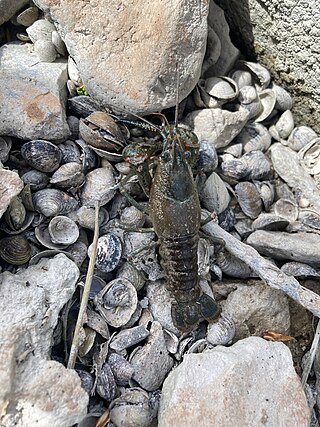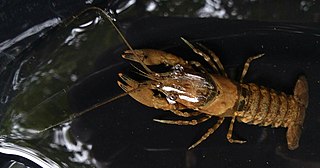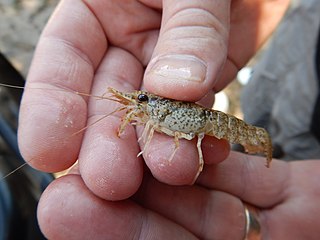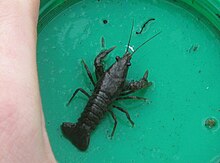
The signal crayfish is a North American species of crayfish. It was introduced to Europe in the 1960s to supplement the North European Astacus astacus fisheries, which were being damaged by crayfish plague, but the imports turned out to be a carrier of that disease. The signal crayfish is now considered an invasive species across Europe, Japan, and California, ousting native species there.

The rusty crayfish is a large, aggressive species of freshwater crayfish which is native to the United States, in the Ohio River Basin in parts of Ohio, Kentucky, and Indiana. Its range is rapidly expanding across much of eastern North America, displacing native crayfishes in the process. The rusty crayfish was first captured in Illinois in 1973, and has been collected at over 20 locations in the northern portion of the state. In 2005, F. rusticus was found for the first time west of the Continental Divide, in the John Day River, Oregon, which runs into the Columbia River.
Faxonius cooperi, the Flint River crayfish, is a species of crayfish in the family Cambaridae. It is endemic to Alabama and Tennessee in the United States. The common name refers to the Flint River, where the original specimens were found.

Faxonius deanae, the Conchas crayfish is a species of crayfish in the family Cambaridae. It is endemic to the United States. The common name refers to the Conchas Lake, where the original specimens were found.
Faxonius jonesi, the Sucarnoochee River crayfish, is a species of crayfish in the family Cambaridae. The common name refers to the Sucarnoochee River, near where the original specimens were found in Kemper County, Mississippi. It is endemic to Mississippi and Alabama in the United States.
Faxonius quadruncus, the St. Francis River crayfish, is a species of crayfish in the family Cambaridae. It is endemic to Missouri. The common name refers to the St. Francis River where the first examples were found.
Faxonius stannardi, the Little Wabash crayfish, is a species of crayfish in the family Cambaridae. It is endemic to Illinois. The common name refers to the Little Wabash River, where the original specimens were found.

Faxonius limosus, synonym Orconectes limosus, is a species of crayfish in the family Cambaridae. It is native to the east coast of North America, from Quebec to the lower James River, Virginia, but has also been introduced to Europe. It is known commonly as the spinycheek crayfish or Kamberkrebs in German.

The marbled crayfish or Marmorkrebs is a parthenogenetic crayfish that was discovered in the pet trade in Germany in 1995. Marbled crayfish are closely related to the "slough crayfish", Procambarus fallax, which is widely distributed across Florida. No natural populations of marbled crayfish are known. Information provided by one of the original pet traders as to where the marbled crayfish originated was deemed "totally confusing and unreliable". The informal name Marmorkrebs is German for "marbled crayfish".

Faxonius obscurus is a species of crayfish in the family Cambaridae. It is native to the northeastern United States, where it occurs in Maryland, New York, Ohio, Pennsylvania, Virginia, and West Virginia. It is an introduced species in adjacent regions, including Massachusetts, Vermont, and Ontario in Canada. It is known commonly as the Allegheny crayfish and the obscure crayfish.

Faxonius immunis is a species of crayfish in the family Cambaridae. It is native to North America and it is an introduced species in Europe, where it lives along the Upper Rhine. Its common names include calico crayfish and papershell crayfish.
Faxonius alabamensis, the Alabama crayfish, is a species of freshwater crayfish that lives in Alabama, Mississippi and Tennessee.

Faxonius erichsonianus is a species in the family Cambaridae ("crayfishes"), in the order Decapoda. A common name for Faxonius erichsonianus is reticulate crayfish. Faxonius erichsonianus is found in the south eastern United States of America.

Procambarus acutus, the white river crayfish, is a species of crayfish in the family Cambaridae. It is found in North America and Europe.

Faxonius validus, the powerful crayfish, is a species of crayfish in the family Cambaridae. It is found in North America.

Faxonius is a genus of freshwater crayfish in the family Cambaridae. There are more than 90 described species in Faxonius. It includes the rusty crayfish, an invasive species in North America, and three species, F. virilis, F. immunis, and F. limosus, that are invasive to Europe.

Faxonius lancifer, the shrimp crayfish, is a species of crayfish in the family Cambaridae. It is widespread in the South-Eastern United States.

Faxonius neglectus, a species of freshwater crayfish also known as the ringed crayfish, is native to Central North America, with two major disjunct areas of distribution in the Ozarks and around Nebraska. The species name, Faxonius neglectus, was previously Orconectes neglectus. Faxonius was declared its own genus in 2017 by Crandall & De Grave, as many previously thought Orconectes species were found to not reside in caves.
















